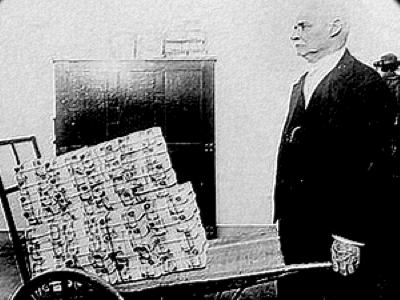
When a country’s monthly inflation rate exceeds 50% – that is close to an annual rate of 13,000% – it qualifies as a hyperinflation.
Episodes of hyperinflation are rare. they have only occurred when the supply of money has been governed by discretionary paper money standards. No hyperinflation has ever been recorded when money has been commodity-based or when paper money has been convertible into a commodity. The first hyperinflation occurred during the French Revolution (1789-96). As the accompanying table indicates, the French episode was followed by 28 additional hyperinflations—all in the twentieth century.
Perhaps the most well-known was the great German hyperinflation of the 1920s, when the monthly inflation rate peaked at approximately 30,000% in October 1923. The two most virulent hyperinflations ever recorded – Hungary (1945-46) and Yugoslavia (1992-94) – curiously remain little known. Perhaps this is because the peak monthly inflation rates were so high as to be incomprehensible. This problem can be overcome by thinking in terms of daily inflation rates, however. On that metric, the highest daily inflation rate ever recorded was in Hungary on July 10, 1946, when the daily rate was 348.46%.
The accompanying chart plots the destruction of the German mark against the US dollar during the world’s most well-known hyperinflation. It also plots the decimation of the Yugoslav dinar against the US dollar during the last great hyperinflation of the twentieth century. Under Slobodan Milosevic’s rule, Yugoslavia recorded the second-highest monthly inflation rate in history, a whopping 313 million percent in January 1994. While much higher than the German peak-monthly rate, the Yugoslav rate was much lower than the record monthly rate which was chalked up by Hungary in July 1946. This brings us to the world’s thirtieth, and this century’s first, hyperinflation. Robert Mugabe’s Zimbabwe has been engulfed in a hyperinflation since March 2007.

Absent current data, we don’t know exactly what today’s inflation rate is. However, we do know the course of the Zimbabwe dollar against the US dollar (see chart). The destruction of Mugabe’s dollar is approaching that which visited the German mark in the 1920s but it’s not yet close to the ruin of Milosevic’s Yugoslav dinar. Everyone knows that high inflation rates inflict untold damage on a country’s economy and misery on its suffering citizens. Zimbabwe’s inflation has pushed its inhabitants into poverty and forced millions of Zimbabweans to emigrate. Between 1997 and 2007, cumulative inflation was nearly 3.8 billion percent, while living standards fell by 38%.The source of Zimbabwe’s hyperinflation is the Reserve Bank of Zimbabwe’s money machine. The government spends, and the RBZ finances the spending by printing money.
The RBZ has no ability in practice to resist the government’s demands for cash. Accordingly, the RBZ cannot hope to regain credibility anytime soon. To stop hyperinflation, Zimbabwe needs to immediately adopt a different monetary system.

Three choices
Any one of three options can rapidly slash the inflation rate and restore stability and growth to the Zimbabwean economy. First is “dollarization.” This option would replace the discredited Zimbabwe dollar with a foreign currency, such as the US dollar or the South African rand. Second is a currency board. Under that system, the Zimbabwe dollar would be credible because it would be fully backed by a foreign reserve currency and would be freely convertible into the reserve currency at a fixed rate on demand.
Third is free banking. This option would allow commercial banks to issue their own private notes and other liabilities with minimum government regulation.Central banking is the only monetary system that has ever created hyperinflation and instability in Zimbabwe. Prior to central banking, Zimbabwe had a rich monetary experience in which a free banking system and a currency board system performed well. It is time for Zimbabwe to adopt one of these proven monetary systems and discard its failed experiment with central banking.
Will this happen any time soon? The answer is not clear. It is surprising how long the perpetrator of a hyperinflation can stay in power. Yugoslavia’s hyperinflation peaked in January 1994 but Yugoslavs suffered for nearly eight more years of high inflation until Milosevic reluctantly conceded defeat after the September 2001 elections.
Yugoslavia’s experience with currency destruction, hyperinflation and a determined dictator is sobering. Those who believe hyperinflation will bring down Robert Mugabe rapidly might, unfortunately, be engaging in wishful thinking.
That said, there is room to end on an optimistic note: the life of most governments that have used the printing presses to create hyperinflation have been much shorter than Milosevic’s. And there are proven remedies to bring hyperinflations to an abrupt halt.
Author Steve H. Hanke

0 responses on "Hyperinflation: Mugabe Versus Milosevic"